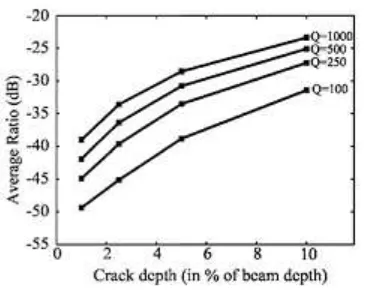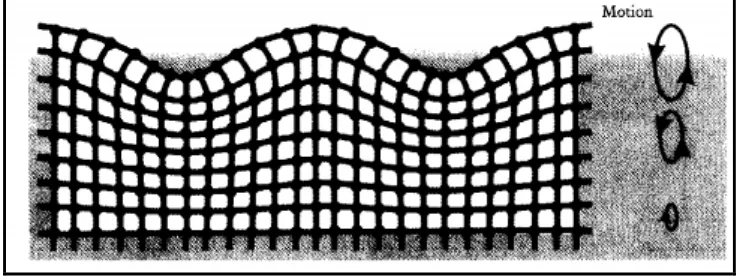SUPERVISOR DECLARATION
“I hereby declare that I have read this thesis and in my opinion this report is sufficient in terms of scope and quality for the award of the degree of
Bachelor of Mechanical Engineering (structure and material)”
Signature : ... Supervisor : ……… Date : ………
Signature : ...
2nd Supervisor : ………
ii
DECLARATION
“I hereby declare that the work in this report is my own except for summaries and quotations which have been duly acknowledged.”
iii
iv
ACKNOWLEDGEMENTS
Assalamualaikum w.b.t
On this occasion, I wish to express, and thanks to my supervisor, Dr. Ruztamreen b. Jenal, He has served me for help in completing the first undergraduate. Not forgetting my parents and friends who helped me a lot in the completion of a Bachelor Degree Project report. Without them I might not be fully complete these papers. Their service is really huge to me.
v
ABSTRACT
Non linear acoustics is one of the analytical methods used for the purpose of reviewing whether a specimen has a disability or not. Apart from studying the specimen, it also aims to analyze the defects that occur in the specimen. These methods include the use or transfer of a function called "transfer function". Transfer function is used to generate a graph and the graph, we can make comparisons when there is a defect in material or not.
This relationship involves the material elasticity and nonlinear acoustic effects. Elasticity of materials depends on the properties of young modulus of plate such as aluminum which has elasticity 72400 MPa. Aluminum is easily established, cheap and readily available. In addition, aluminum is a medium elasticity causes aluminum are choose as a specimens selected experiments.
However, in this investigation, we used ABAQUS software is a software technology without involving the destruction of the plate and analysis Finite Element Method (FEM). These methods include the investigation of the properties of materials (Aluminum). As such we can see the properties of aluminum that has a density of 2780 kg / m³ and the Poisson ratio of 0.33. From these characteristics, we can see the changes that occur in the specimens, especially in the frequency. This is because the main focus is the frequency.
vi
ABSTRAK
Non linear akustik adalah salah satu kaedah analisis yang digunapakai untuk tujuan mengkaji spesimen samada mempunyai kecacatan ataupun tidak. Selain daripada mengkaji spesimen, ia juga bertujuan menganalisis tahap kecacatan yang berlaku pada specimen. Kaedah ini meliputi penggunaan persamaan fungsi pemindahan atau dikenali “transfer function”. Fungsi pemindahan digunakan untuk menghasilkan graf dan daripada graf tersebut , kita akan dapat membuat perbandingan apabila wujudnya kecacatan pada bahan ataupun tidak.
Hubungan ini melibatkan kekenyalan bahan dengan kesan non linear akustik. Kekenyalan bahan bergantung kepada sifat modulus young bahan tersebut contohnya aluminium yang mempunyai kekenyalan 72400 Mpa. Aluminium bersifat mudah dibentuk, murah dan mudah didapati. Selain itu kerana sifat kekenyalannya yang sederhana menyebabkan alluminium dipilih sabagai spesimen ujikaji.
Walaubagaimanapun, dalam penyiasatan ini, kita menggunakan perisian ABAQUS iaitu satu perisian menggunakan teknologi tanpa melibatkan kemusnahan plat dan melibatkan analisis unsur tidak terhingga. Kaedah ini meliputi penyiasatan melalui sifat-sifat bahan (alluminium) tersebut. Sepertimana kita dapat melihat sifat aluminum yang mempunyai ketumpatan 2780 kg/m³ dan nisbah poisson 0.33. Daripada ciri-ciri tersebut, maka kita boleh melihat perubahan yang berlaku pada spesimen terutama melalui frekuensinya. Ini kerana fokus utama adalah kepada frekuensi.
vii
TABLE OF CONTENTS
CHAPTER CONTENTS PAGES
ACKNOWLEDGEMENT iv
ABSTRACT v
ABSTRAK vi
CONTENTS vii
LIST OF FIGURE ix
LIST OF TABLE xii
NOMENCLATURE xii
APPENDIXS
1.1 Gantt Chart PSM 1 1.2 Gantt Chart PSM II
1.3 Result Frequency uncracked (1-6) 1.4 Result Frequency uncracked (932-939) 1.5 Result Frequency cracked (1-6)
1.6 Transfer Function Matrix 1.7 R Value Analysis
CHAPTER 1 INTRODUCTION
1.1 Background 1
1.2 Objective 3
1.3 Outline of the Thesis 4
viii
CHAPTER 2
DAMAGE DETECTION BY USING NONLINEAR
ACCOUSTIC EFFECT
2.1 Introduction 5
2.2 Crack Detection Method 7
2.2.1 Analytical Modeling Method 7 2.2.2 Finite Element Method (Fem) 9
2.3 Non-Linear Acoustics 11
2.3.1 Surface Acoustic Waves 11 2.3.2 Nonlinear Acoustic Mechanisms 13 2.3.3 Non Linear Elasticity 13
2.4 Harmonics Generation 15
2.5 Sidebands Generation And Amplitude Modulation
15
2.6 Summary 16
CHAPTER 3 FINITE ELEMENT ANALYSIS
3.1 Flow Analysis 17
3.2 Modal Analysis 19
3.3 Modal Analysis Using Finiti Element
Method (FEM) 19
3.4 Uncracked Plate 20
3.5 Cracked Plate 23
3.6 Frequency Response Matrix H ώ 26
3.7 Model Diagram 27
3.8 Modulus Intensity( R Value) 28
CHAPTER 4 MODAL ANALYSIS OF ALUMINUM
ix
4.2 Mode Shape 29
4.2.1 Mode Shape Uncracked Results 30 4.2.2 Mode Shape Cracked Stiffness 34 4.3 Natural Frequency Response Function
For Plates With Several Of Stiffness Value At Center Area
37
4.4 Transfer Function Result 39
CHAPTER 5 RESULT ANALYSIS
5.1 Analysis Results 41
5.2 Optimizing Of Frequency Range 41 5.3 Natural Frequency Shifting 43 5.4 Modulation Intensity (R Value) Against
Stiffness
45
5.5 Conclusion 47
CHAPTER 6 CONCLUSION AND RECOMMENDATIONS
6.1 SUMMARY OF RESEARCH 48
6.2 CONCLUSIONS 49
6.3 RECOMMENDATIONS 50
x
LIST OF FIGURE
NO TITLE PAGES
Figure 2.1 : specimen with impact damage area 6
Figure 2.2 : step simulation to analysis of specimen 7
Figure 2.3 receptance analysis 9
Figure2.4 : A cracked beam is decomposed into three plain beams where the cracked section is represented by a short reduced cross section beam
10
Figure 2.5 : (a)Finite Element Method 10
(b) Average of R value against crack size with various damping factors
11
Figure 2.6 : Particles move in ellipses in a surface acoustic wave. The amplitudes decrease exponentially with depth
12
Figure 2.7 : stress-strain curve for sandstone of nonlinear and linear elasticity
14
Figure 2.8 : stress-strain curve for the glass characteristics of nonlinear and linear elasticity
14
Figure 3.1 : procedure of analysis 18
Figure 3.2 : Method to create and analysis part using Finite Element Analysis 0f ABAQUS software
20
Figure 3.3 : Model Plate for uncracked (150 mm x 400 mm x 2 mm ) 22 Figure 3.4 : Material properties of the aluminum plate model for FE
analysis
23
Figure 3.5 : model aluminum plate 24
xi
Figure 3.7 : dimension of sensor 27
Figure 4.1 : picture uncracked with stiffness, E = 69 Gpa 33
Figure 4.3 : Plate response 38
Figure 5.2 : Graph optimizing frequency range and total quantity 1700 42 Figure 5.4 : result of natural frequency shifting versus stiffness for the
aluminum plate at various vibration modes excitation from FE method
44
xii
LIST OF TABLE
NO TITLE PAGES
Table 4.2 : natural frequency result 37
Table 4.4 : natural frequency from z-direction 39
Table 5.1 : Total number of Frequency range 42
Table 5.3 : Percentage of natural frequency shifting of uncracked and cracked plate
43
Table 5.5 : Diagram shows the stiffness reduction with the average R value
45
NOMENCLATURE Bo Mean value of the modulation signal
Bı Peak-to-peak variation around the modulation
E Modulus of elasticity
fο Fundamental frequency
H i j (w) Transfer function value at frequency between points i and j wn Natural frequency at mode n
1
CHAPTER 1
INTRODUCTION
1.1BACKGROUND
In today's world, engineering is an important area to meet modern times. Development time is the time of the sophisticated and people can move fast without any restrictions. As now, researchers may be studying equipment or materials without destroying the material. In this analysis involves the simulation using ABAQUS software. ABAQUS is a suite of software applications for Finite Element Analysis (FEA) and computer-aided engineering.
ABAQUS is used in the automotive, aerospace, and industries products. The software is popular with academic and research institutions due to the wide material modeling capability, and the program's ability to be customized. Software ABAQUS also provides a good collection of multiphysics capabilities, such as coupled acoustic-structural, piezoelectric, and structural-pore capabilities, making it attractive for production-level simulations where multiple fields need to be coupled. However, this research is to use the software to investigate the relationship between material stiffness with non linear acoustics effect using plates.
2 material. A high modulus of elasticity is sought when deflections are undesirable, while a low modulus of elasticity is required when flexibility is needed.
While, non linear acoustic is to review, evaluate and analyze the relationship between material stiffness with nonlinear acoustic. In this situation, two different properties of structure will be placed elasticity properties investigated and different properties of a material considered as a defect (damage). It is an essential element either qualitatively or quantitatively to determine the presence of damage to prevent any consequences that could lead to catastrophe. Nonlinear are used in the method for crack detection in metallic structures. This method involved frequency modulation, side bands, mode shape and changes in frequencies. Although all these effects are crucial for incipient damage detection, their physical explanation is still not well understood [4]. However, it is generally agreed that the interaction between the high-frequency acoustical wave and the low-frequency modal excitation is important for crack detection. The application of this method in real engineering fields is very limited.
Damage in material can happen by many mechanisms. Damage is one that is common in structural materials. As such, damage modeling has been a remarkably active trend in the Engineering community since the 50s, so that it is largely beyond our scope even to try to review the huge existing literature on this subject. This paper covers methods of detecting damage (different properties) in the structure and frequency response. Damage in structures can be defined as changes of material or geometric properties in a structure that could affect the structure’s performance. In solid material like metal, Jean Lemaitre (2005) [2] defined damage as the creation and growth of micro voids or micro cracks that create discontinuities in a homogeneous material.
3 techniques are dye penetration, magnetic particle, eddy-current, radiography, ultrasonic and acoustic emission, as summarized by Staszewski et. al. (2004) [3] and Gdoutus [5].
In this technique the condition of a structure is determined and quantified by inspecting changes in its global structural characteristics. Simulation is one of the methods are categorized as Non-Destructive Testing (NDT) which is a method used to detect or measure defects of a material or system without damaging the material being tested. This method plays an important role in medical technology, quality control and shelf life determination of a structure. It is widely used in the manufacture of petrochemicals, power sources, transportation and civil engineering. There are a variety of NDT techniques and these techniques should be used together, depending on the material being tested. Almost all metal or non-metallic materials tested by NDT techniques. For the sake of safety, reliability and operational life, it is essential to monitor the health status of structural systems.
1.2 OBJECTIVE
Nonlinear acoustics will be used for damage detection in a structure. The main focus will be in simulation of Finite Element Analysis (FEA) using ABAQUS software. The ultimate objective of the research work presented to analyze the Modulus Intensity (R value) behind these nonlinear acoustic modulations in the presence of the crack. In order to achieve these objectives that project aims to:
i. To evaluate the effect of stiffness changes in small area that representing fatigue crack on plate.
4 1.3 OUTLINE OF THE THESIS
A brief summary of the thesis is presented in this section. The research work undertaken consists of two major parts. Firstly, finite element modeling is used to establish excitation frequencies for nonlinear acoustics. Secondly, analyze result to perform and to investigate Modulus Intensity (R value) for nonlinear acoustic modulations in the presence of the stiffness.
Damage detection by using nonlinear acoustic effects are reviewed in a chapter 2. This chapter indicates the explanation of crack detection method and analytical modeling method.
Finite Element Analysis (FEA) is described in chapter 3. Finite Element Analysis focused to the uncrack and crack of the aluminum plate. Analysis of structure used the ABAQUS software.
Next chapter discussed the modal analysis of the aluminum plate that conducted to know the mode shape of the structure. This chapter consists of the result uncrack and cracked plate structure of the mode shape and frequency response function.
Result analysis can to get after modal analysis is being described. Relation between material stiffness against modulation intensity (R Value) can to look. Last chapter is a conclusion and recommendation of the thesis. Scope of this study is only limited the analytical analysis using Finite Element Method with use of ABAQUS software.
1.4 PROBLEM STATEMENT
Projek Sarjana Muda 5
CHAPTER 2
DAMAGE DETECTION BY USING NONLINEAR ACOUSTIC EFFECT
2.1 INTRODUCTION
There are many ways that we can use to analyze whether the product can be safely used or whether it is in good condition or not. Non-destructive testing is the best method. This is because, it not only saves cost but also the products used for the analysis can also be used again. An examples of the ways that we commonly as magnetic particle, dye penetration, eddy current, radiography, ultrasound and others againstsummarized by Staszewski et. al. (2004) and Gdoutus. However, the overall methodology used to test the different deformities.
Magnetic particle is a method of using the principle that a flaw in magnetic material produces distortion in an induced magnetic field. The method is easy, fast and economical to apply, but similarly to the dye penetration method it can only be used to detect cracks or damage near the applied surface.
Dye penetration is a method of applying colour or fluorescent dye onto the cleaned surface of a component to detect any surface flaws. After applying the dye onto any surface and applying a post-penetrant material such as chalk, flaws will appear as coloured lines. It is a fast method for damage detection and can detect small cracks, but it is only capable of detecting surface flaws.
Projek Sarjana Muda 6
placed near the conductor surface to induce an eddy current. The sensitivity of the method to the defect is dependent on the penetration depth of the eddy current into the conductor and is influenced by the frequency of the alternating current, the magnetic permeability and electrical conductivity of the conductor, and the geometry of the coil and conductor. Therefore the method is highly sensitive for defects near the conductor surface but it is difficult to relate the defect size to the impedance change and the impedance change is also affected by others factors.
Radiography is the oldest NDT method and uses X- or γ-ray to detect a defect. The X-ray is transmitted to a tested material and the emerging radiation is measured. If the material contains defects or variations in its thickness or density, the emerged radiation intensity will not be uniform. This method is suitable for detecting volumetric defects. However it is important to know the orientation of the defect beforehand to get the best effect.
Ultrasound is a method of transmitting ultrasonic waves into a test material. Any defects and boundaries in the specimen will reflect a pulse wave and the reflection waves are measured. By using the reflection wave data, the defect size and location can be estimated. It is a very effective method for detecting defects in most positions, gives a quick response, is economical, is applicable to thick material, and is highly portable in-situ. However, it is very difficult to distinguish between cracks and other types of defect and it has limited application to certain specimen geometry. We can see an example as follows:
Projek Sarjana Muda 7
The above diagram (figure 2-1) shows an example of the damage that we can analyze occurred in a surface structure. Damage occurred in the middle. It may be due to various factors.
2.2 CRACK DETECTION METHOD
Detection of damage in a structure can be done in various ways. Each of the methods used would have its own advantages and disadvantages. However, damage detection can to divide two main categories: experimental and analysis.This part will present analytical modeling examples by previous researchers using nonlinear acoustics methods for defects like stiffness material.
2.2.1 ANALYTICAL MODELLING METHOD
In the analysis of the structure, a mathematical formula can also be used for the detection of non-linear effects caused by wave distortion when interacted with nonlinearity or non-uniformity of its passage medium. Mathematical modeling method can to use to show non linear wave effect graph.
Projek Sarjana Muda 8
That graph can to show via of non linear phenomena of sideband.To make a structural analysis of ABAQUS software should be used first to obtain the response frequency and nonlinear wave effect. Figure 2-2 show step simulation of the specimen. So we can see the relationship between the stiffness of the (R value). From this, they derived the sideband amplitude ratio over the fundamental frequency f0
amplitude, R value, as:
2 │Ho ( f 0 ) – Hc ( f 0 )│ 2 B1
R = – ––––––––––––––––– = – – ………... Eq. 2.1
│Ho ( f 0 ) + Hc ( f 0 )│ B0
Where HO and HC are transfer function values when the crack is fully open and closed
HO C
BO = ––––––– is mean value of the modulation signal
2
HO - HC
BO = ––––––– is the peak-to-peak variation around the modulation
2
The transfer functions were computed by using a standard analytical formula written as
U inU jn
H i j (w) = ∑ ––––––––––––––––––––––––– ……….. Eq. 2.2 n wn2 + i wnw / Qn - w2
Where H i j (w) denotes transfer function value at frequency w between points i and j. U i/j n is mode shape value at location i/j for mode n
wn is natural frequency at mode n Qn is damping factor at mode n
Projek Sarjana Muda 9
2.2.2 FINITE ELEMENT METHOD (FEM)
The finite element method (FEM) originated from the need for solving complex elasticity and structural analysis problems. The finite element method (FEM) (its practical application often known as finite element analysis (FEA)) is a numerical technique for finding approximate solutions specializations of the mechanical engineering such as automotive industries commonly use integrated FEM in design and development of the structure. In a structural simulation, FEM helps tremendously in producing stiffness and strength visualizations and also in minimizing weight, materials, and costs.
FEM is also popular method for analyzing structural vibration responses. With rapid development in computing and software technology, this method has become more reliable and problem solving has become faster. The results from this analysis also showed clearly the dependence of R value on the fundamental frequency and damping factor may also affect sensitivity of the nonlinear acoustics method. The fundamental frequency resulted from the FEM. It also shows the sensitivity of the R value.
Figure 2-3: Ratio of first sideband amplitude over fundamental frequency amplitude, R value, against the ultrasound frequency resulted (R.B Jenal- fatigue crack detection using nonlinear acoustic – analysis of vibro-acoustic modulations) :
Projek Sarjana Muda 10
Receptance analysis is an analytical method of decomposing a system into a few sub-systems to analyze a system’s vibration responses.As presented by Duffour et al., this method was used to model a beam schematically described in Figure 2-4. The beam was divided into three sections, where the cracked section was represented by a very short beam (no.2) with a reduced cross-section area compared to the other two sections (nos 1 and 3). The cross-section area was dependent on the crack depth.
Figure 2-4: A cracked beam is decomposed into three plain beams where the cracked section is represented by a short reduced cross section beam (Duffour)
First they calculated the natural frequencies and mode shape coefficients of each beam section by using standard theory for the longitudinal vibration of uniform bars. The results were substituted into Equation 2-2 and then the results from each section were assembled by using a coupling formula for linear system in series. Finally the R values were determined by using Equation 2-1 within a frequency range.
The results from this analysis showed that the sensitivity of using the nonlinear acoustic effect for damage detection is extremely dependent on the fundamental frequency and it should be close to the resonances of the specimen. Damping factors for the specimen also may affect this method sensitivity.
Projek Sarjana Muda 11
Figure 2-5 (b) and (c): Ratio of first sideband amplitude over fundamental frequency amplitude, R value, against the ultrasound frequency resulted ((R.B Jenal- fatigue crack detection using nonlinear acoustic – analysis of vibro-acoustic modulations) :
Figure 2-5 : (b) Average of R value against crack size with various damping factors (Duffour)
2.3 NON-LINEAR ACOUSTICS
Non-linear acoustics is a branch of physics dealing with sound waves being distorted. The amplitude dependence is due to the nonlinear response of the medium in which the frequency propagates, and not to the nonlinear behavior of the sound source. According to the linear theory of acoustics, increasing the level of a source by 10 dB results in precisely the same sound field as before, just 10 dB more intense. Linear theory also predicts that only frequency components radiated directly by the source can be present in the sound field.
2.3.1 SURFACE ACOUSTIC WAVES
Projek Sarjana Muda 12
about one wavelength. Instead of propagating thought-out the whole three-dimensional medium, the energy remains localized at the surface and spreads out primarily in the two-dimensional (2D) interface region.
Waves illustrated the principal features of elastic surface waves. The particle motion can be easily visualized when a waves passes a leaf floating on the waves surface. The leaf moves to and fro, but also up and down around its original position. The radius of the particle orbit is equal to the wave amplitude (H.Peter - Surface acoustics waves materials science).
Elastic surface waves, usually called surface acoustic waves (SAWs) were discovered in 1885 by Lord Rayleigh. SAWs depend on the elastic forces acting between the constituent atoms. The internal forces of medium, or stress, are assumed to depend only on the deformation of the material, or strain , measured relative to the undisturbed state. In the bulk of an elastic material, the longitudinal and transverse waves modes are independent and propagate with different velocities, but in surface waves the two modes are coupled. Due to the asymmetry of the elastic forces at the surface, the motion normal to the surface may be different from that in the direction of wave propagation along the surface. Consequently, in the elastic medium, the particle motion is elliptical polarized. The depth dependence of the particle displacement and polarization are illustrated in figure 2.6.





